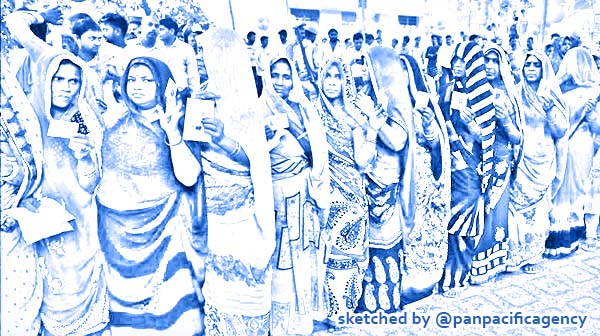[Analytics] India chooses Modi 2.0 in clean sweep

The average turnout over nine phases in 2014 was 66 per cent, the highest ever in the history of Indian general elections. (Photo: AP). Sketched by the Pan Pacific Agency.
The Bharatiya Janata Party is set for a resounding comeback as leads pouring in from all over the country have given the party and its allies an absolute majority for a second term. The BJP reached the half way mark on its own like last term. As many as 5 exit polls projected the BJP-led National Democratic Alliance is all set to retain power at the Centre, reported the Asian Age.
Narendra Modi created history by becoming the only non-Congress Prime Minister to have stomped back to power.
The Congress and allies have bettered its tally from 2014, but still came a very distant second. The non-aligned parties are also not putting up much of a show, losing ground from last term.
The BJP and its allies were leading in 326 (-26) seats, Congress and allies in 100 (+35) and the non-aligned parties in 115 (-10) seats.
The BJP was leading in most Hindi heartland states and has made significant inroads in West Bengal, Odisha and Karnataka. The Congress was leading in Punjab and Tamil Nadu where it has teamed up with the Stalin’s DMK.
The SP-BSP mahagathbandhan in Uttar Pradesh was a big failure. The fabled arithmetic failed to live up to its promise. The BJP could well end up with 60 seats.
Trends also show that the Opposition’s bid to create an alternate dispensation has come a cropper.
Psephologist and politician, Yogendra Yadav said that the “left, liberals and intellectuals had failed to read the signs”.
Prime Minister Narendra Modi was leading from Varanasi. Congress president Rahul Gandhi was trailing in Amethi against BJP’s Smriti Irani, but leading from Wayanad in Kerala. UPA chairperson Sonia Gandhi was leading from Rae Bareli.
Elections were held in 542 of 543 seats and a party needs 272 seats to form government.
It has been a seven-phase polling from April 11 to May 19 with leaders stomping all over the country, holding rallies and enthusing people to vote.
As many as five exit polls on Sunday projected that the BJP-led National Democratic Alliance is all set to retain power at the Centre, riding yet another ‘Narendra Modi wave’.
This, despite the Congress-led Opposition making frenetic efforts to dent the Modi citadel by raising issues like corruption, unemployment, demonetisation and inflation.
Exit polls that predicted that NDA may fall short of majority numbers were in a poor minority.
Voting for the marathon seven-phase elections logged a record final turnout of 67.37 per cent in 542 Parliamentary constituencies. There was an increase of 1.3 per cent in overall voting turnout this time. Even Mumbai, known to be a laggard at voting, showcased its best performance in three decades at 55 per cent.
The average turnout over nine phases in 2014 was 66 per cent, the highest ever in the history of Indian general elections. Over 8,000 candidates were in fray this time.
It has been a hotly contested campaign trail, with virulent rhetoric and mudslinging marking speeches.
The ruling BJP-led National Democratic Alliance, particularly top leaders including Prime Minister Narendra Modi, stuck to a robust nationalism script, peddling surgical strikes, national security and an anti-terror, anti-Pakistan stance as the backbone of its campaign. They shredded the Opposition to pieces on issues of corruption and financial improbity. Modi called himself the ‘chowkidar’ of the country.
The Congress-led United Progressive Alliance’s voice was equally stringent, largely concentrating on Modi, his promises and his alleged failures. ‘Chowkidar chor hai’ was Congress boss Rahul Gandhi’s abiding refrain in his speeches, and in one he went overboard and attributed it to the Supreme Court. He had to unconditionally apologise.
The Congress also intermittently flirted with soft Hindutva – saadhus came out in support of Congress candidate and top leader Digvijaya Singh – to offset the aggressive tone on the other side.
This was also the election that saw Priyanka Gandhi end all speculation and jump into the thick of it all, crowned the party’s general secretary and given charge of East Uttar Pradesh.
Regional party chiefs also played a prominent role in the run-up keeping hopes alive of a Third Front — with or without the Congress — if NDA failed to get the numbers.
Over 900 million Indians were eligible to vote in the elections to constitute the 17th Lok Sabha.
State elections were simultaneously held in Andhra Pradesh, Tamil Nadu, Odisha and Sikkim.
In 2014, the BJP got an absolute majority, winning 282 seats – 166 more than the previous term. Congress had managed 44.